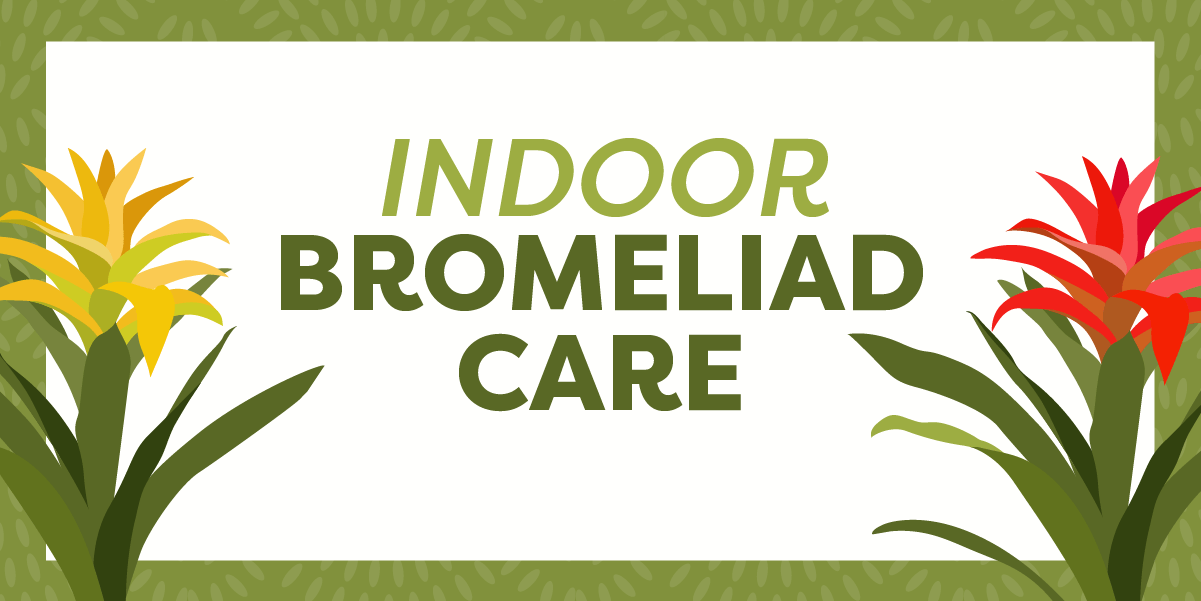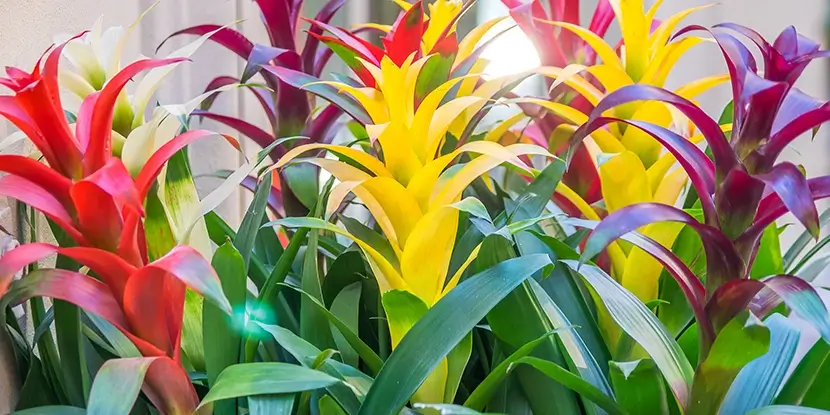Bromeliads are native to Central and South America, growing on rocks, trees, and the ground in wooded and humid areas. They’re some of our most fascinating and beautiful ornamentals.
Their rosette foliage ranges from silvery gray to dark green. It can be variegated with pink and off-white striping.
Bromeliad flowers appear in a captivating array of shapes and colors. They’re often borne on spikes extending above the plant, but in some varieties, they’re almost hidden in the center funnel of the plant and surrounded by brilliant inner leaves. These flowers can be star-shaped, tubular, or rosette-like.
Some species boast vibrant bracts — modified leaves that resemble flowers in their own right — surrounding the true blossoms.
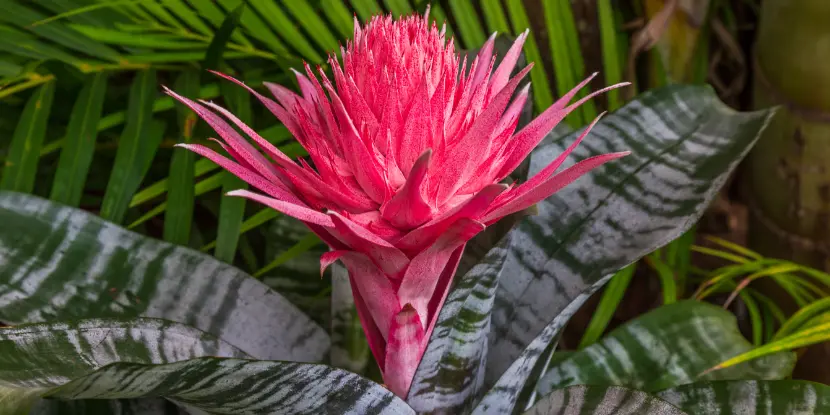
Close-up of a silver vase flower (Aechmea fasciata), a member of the bromeliad family.
The root system of most bromeliads serves mainly as an attachment to rocks, tree bark, or soil. Roots furnish very little food to the plant, whose water supply is stored in a natural vase-like center formed by their durable foliage.
Bromeliads are ideal for home decoration. They can be displayed in pots, hanging baskets, dish gardens, or on bark or driftwood. They’re relatively easy to care for and don’t need to be in large pots or containers.
Light & Temperature
- Bromeliads with variegated foliage are more vivid colored when they receive bright light.
- Filtered sun is preferable; direct sunlight may burn bromeliad foliage.
- Bromeliads like warmth and will suffer damage if temperatures drop below 40°F.
- Keep them away from air conditioning vents or drafts.
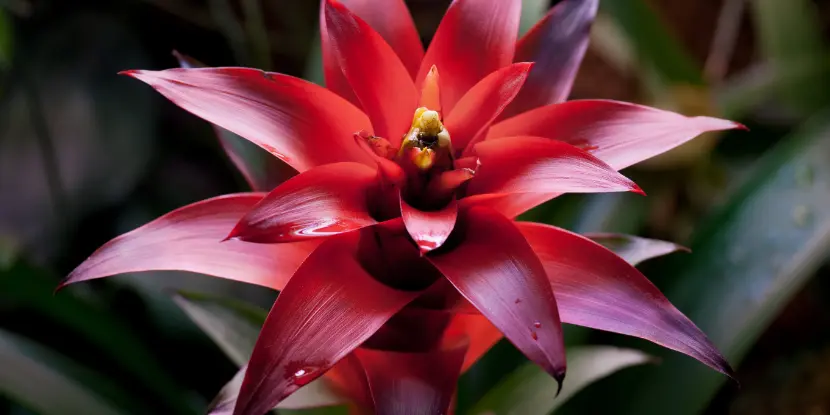
A bromeliad plant in bloom.
Water & Humidity
- The vase-like center of the plant should always contain water, which should be replaced every few weeks to prevent stagnation.
- Mist your bromeliad’s foliage daily with room-temperature water to provide humidity.
- If possible, use filtered or distilled water to prevent the buildup of chemicals and salts that can damage leaves.
- Invert the plant once every two weeks to flush out accumulated salts.
Fertilizing Bromeliads
- Bromeliads need only light applications of a balanced, slow-release fertilizer every 3 months.
- When watering your bromeliad plant’s vase, use a liquid fertilizer diluted to half-strength.
- Don’t fertilize bromeliads that are about to flower or already have.
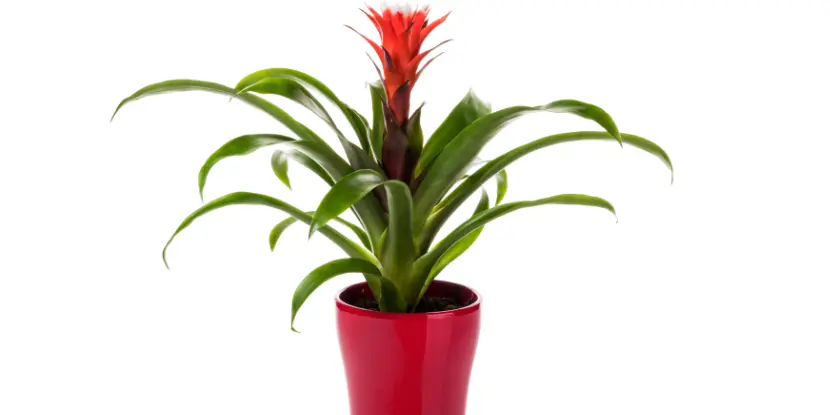
Red Guzmania Bromeliad in flower pot.
Potting Soil
- A mix for bromeliads should be light, porous, and well-draining.
- Combine a half-and-half mixture of peat moss and perlite. You can add some orchid bark to the mix as well.
- Avoid using potting soil for tropical plants or succulents, as it tends to hold too much water.
Propagating & Repotting
- Bromeliads are epiphytic (“air plants”) and don’t need much soil.
- At some point, the parent plant will die after blooming.
- Baby plants — called pups — usually develop around the base of the parent and can be removed when they’re about one-third the size of the mother plant.
- Pot them in a small container with light, well-draining potting mix and keep them warm for several months until new growth begins.
- Once repotted, treat them as mature plants.
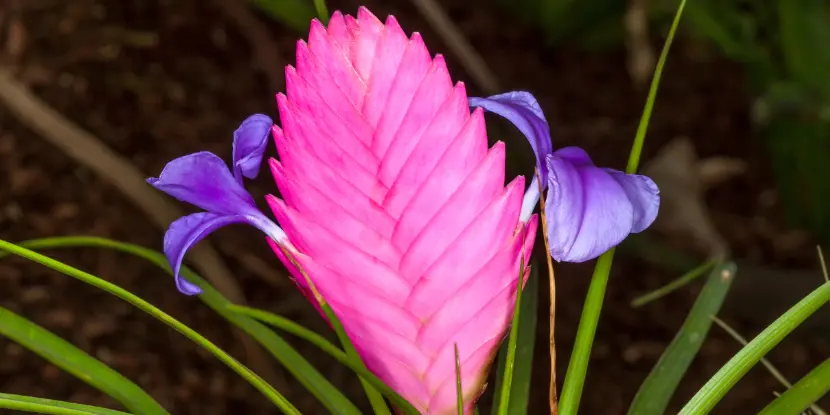
Tillandsia cyanea (pink quill plant) an autumn pink flower bromeliad often used as a house plant.
Pests & Diseases
Bromeliads are generally pest-free but occasionally attract mealybugs, scale insects, and spider mites, especially if kept indoors.
- Wipe the leaves with a damp cloth or use an insecticidal soap spray to treat these pests.
- Root rot is a common problem that can be prevented by keeping the plant’s central cup free of standing water and using well-draining soil.
- Brown tips on leaves may indicate underwatering or too much direct sunlight.
- Yellowing or wilting foliage can be a sign of root rot or over-fertilization.
Conclusion
With a bit of attention to their specific needs, bromeliads can be striking additions to your indoor space. Their unusual appearance and exotic origins make them a conversation piece and a testament to the wonder of nature’s diversity.
By understanding their preferred light conditions, watering habits, and care routines, you can enjoy the vivid flowers and foliage of these fascinating plants for years to come.
FAQs: Indoor Bromeliad Care
Q: How often should I water my indoor bromeliad?
Water your bromeliad plant when the top inch of the soil feels dry. Bromeliads have a central tank or cup — keep this filled with water, but be cautious not to overwater the soil to avoid root rot.
Q: What kind of light do bromeliads need?
Bromeliads prefer bright, indirect sunlight. They can also thrive under fluorescent lights, making them well-suited for indoor environments with less natural light.
Q: Do I need to fertilize my indoor bromeliad, and how often?
Fertilizing isn’t essential but can encourage more vibrant foliage. If you choose to fertilize, do it sparingly and use a half-strength, balanced liquid fertilizer not more than once a month during the growing season.
Q: What is the ideal temperature for indoor bromeliads?
Bromeliads favor temperatures between 60-80°F (15-27°C). They can tolerate fluctuation within this range but avoid drastic temperature changes.
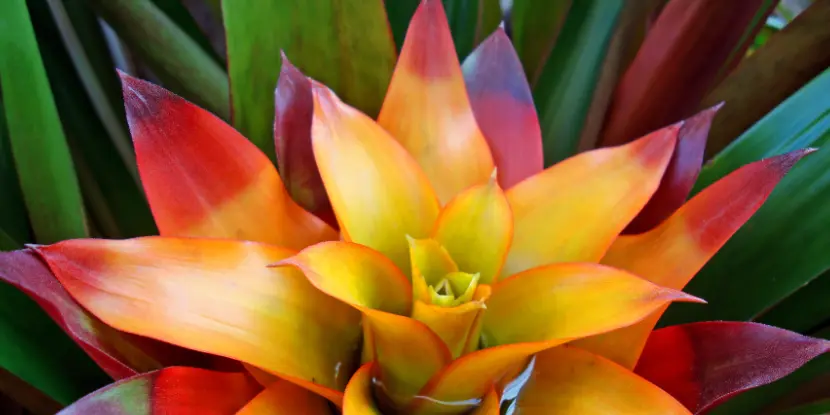
The striking bloom of a bromeliad (Guzmania lingulata).
Q: How do I know if my bromeliad is getting too much light?
If the leaves of your bromeliad become faded, bleached, or scorched, it may be exposed to too much direct sunlight. Move it to a location with bright but more indirect light.
Q: Can bromeliads bloom indoors, and how can I encourage blooming?
Yes, bromeliads can bloom indoors. To encourage blooming, ensure proper care and consider using an ethylene-producing technique, such as placing a ripe apple in a sealed bag near the plant for a few days.
Q: How should I pot my bromeliad?
Use a well-draining potting mix designed for bromeliads or orchids and a pot with good drainage. The pot size should comfortably accommodate the plant’s root system without being overly spacious.
Q: How should I handle pests on my indoor bromeliad?
To combat mites and scale insects, rinse the leaves with water or use insecticidal soap. Avoid harsh chemicals that can damage the plant.
Q: When and how should I repot my bromeliad?
Repot bromeliads infrequently, as they prefer to be slightly root-bound. You typically need to repot only if the plant has outgrown its container or for division of offsets, known as “pups.”
Q: What should I do with the ‘pups’ produced by my bromeliad?
Once the pups are about one-third the size of the parent plant, you can gently remove them and pot them separately to start new plants. Before detaching them, make sure the pups have roots.

